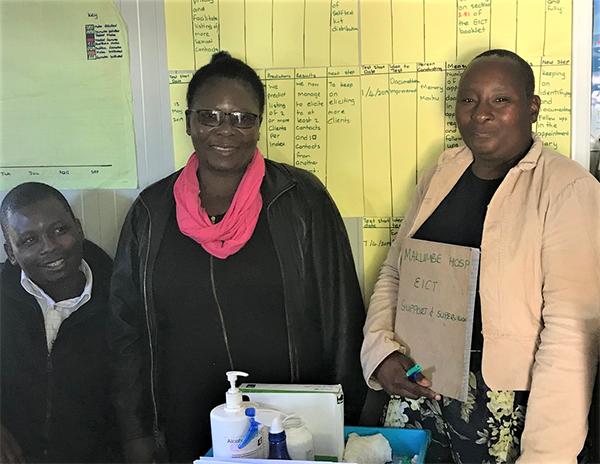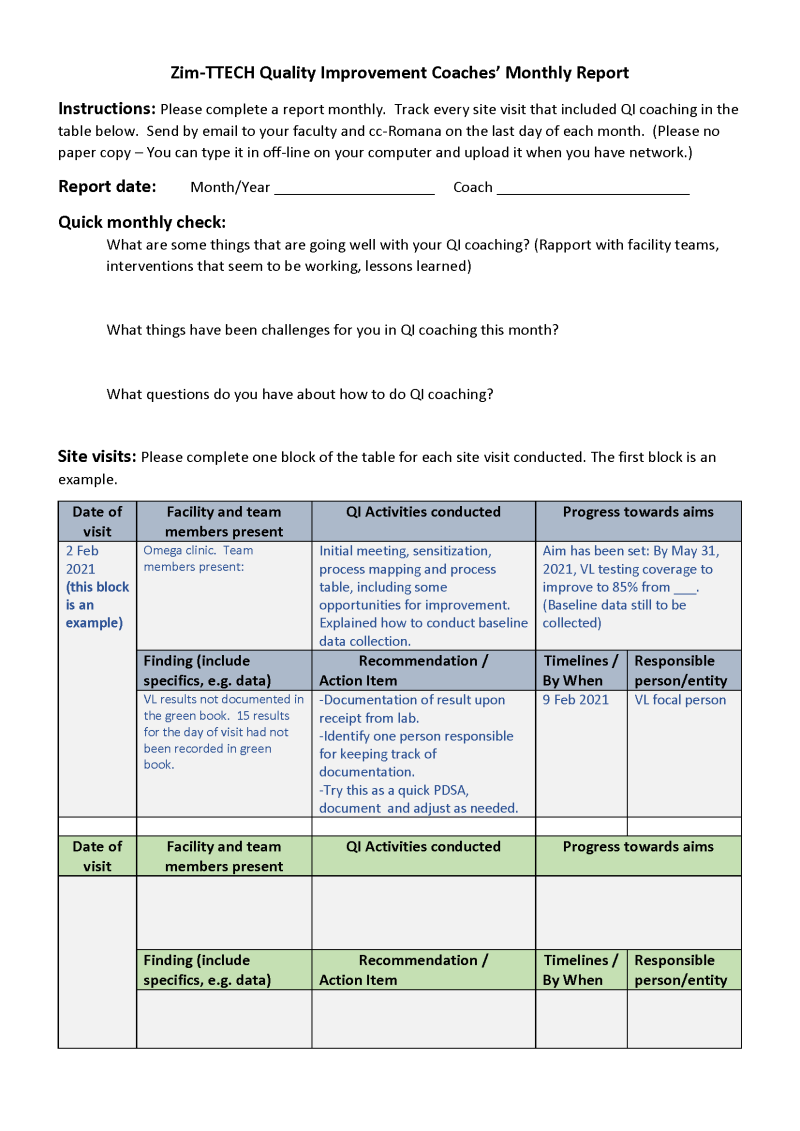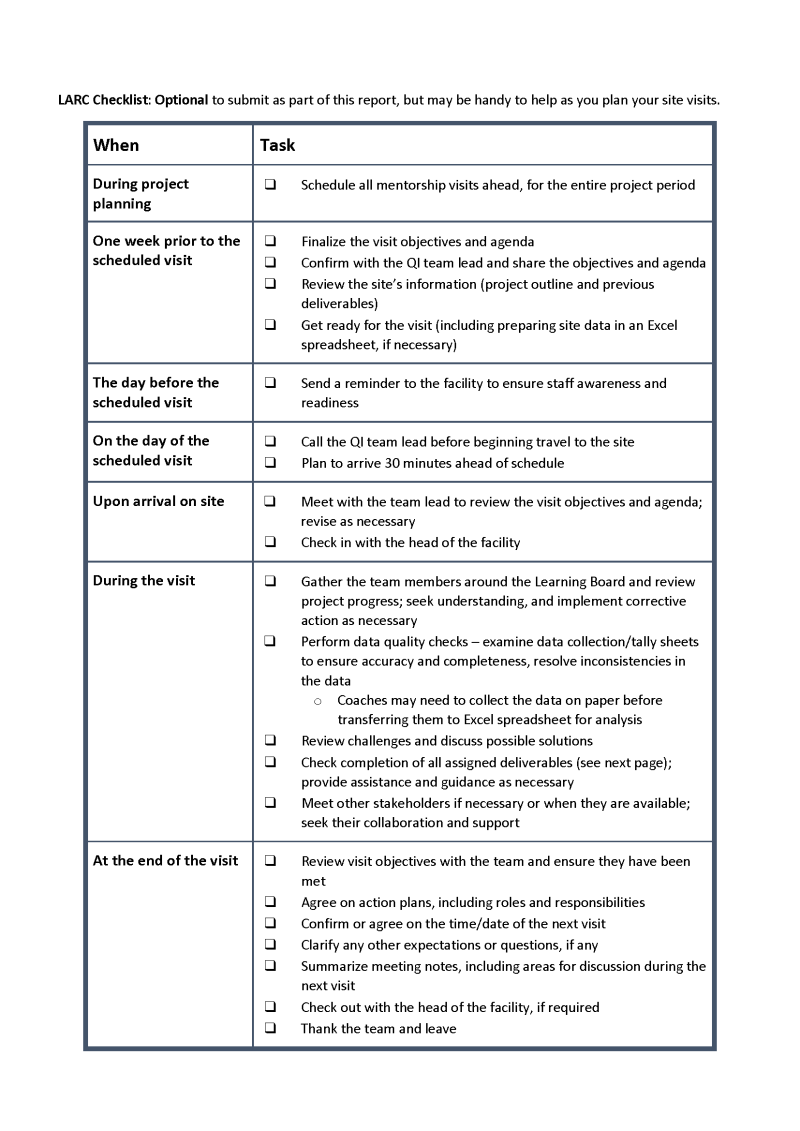Session 1: Introduction to Quality Improvement Coaching
In this session we will provide an overview of building a QI team, the roles and responsibilities of a QI team, and motivating the team. We will emphasise the importance of documentation and introduce you to the case study that will be a part of each session.
Getting Ready For This Session
- Remember to have your workbook and a pen or pencil handy.
- You will need about 60–70 minutes to complete the session.
Learning Objectives
At the end of this session, learners will be able to:
- Describe the role of the QI coach
- List and describe the members of a QI team
- Motivate a team through appreciation of the value of a QI project
- Describe the importance of documentation throughout the life of a QI project
Learning Activities Estimated time:
-
Becoming a QI Coach (5 min)
Welcome to QI coaching—an adventure that leads to exciting rewards and interesting challenges. How are you feeling about this new role? Some of the coaches we surveyed in early 2021 reported a variety of feelings—from excited, hopeful, and motivated to stressed and anxious.
One of the challenges of QI coaching can be that timelines may be tight, creating pressure to learn even as you are teaching. We understand this—and have developed the content throughout this training to support you in both your learning and your ability to be a QI coach to your teams.
As mentioned in the course overview, throughout these sessions, we will be including a variety of information, including a case study that we will follow through each session, and some words of wisdom from experienced coaches, such as Xolani.
Listen to Xolani and Jacky speak of their early experiences as QI coaches.
Transcript

My experience when I started coaching, [was the same as it is] with all new things. My initial experience has been mainly it was excitement, and with looking forward to implementing and effecting the changes towards the goals that the project was looking at. I was anxious about how I was going to conduct the coaching, and looking at the sites, and how I was actually going to implement the objectives of the programme. But I think it has been, overall, exciting to learn as we implement.
The nice thing about the whole process—it has been a win-win for both the sites and me, as I have been learning through the whole process, and the facility and the team have been learning as well. We have both been seeing things in a new light, rather than in a closed or, should I say, just a rigid way of doing things. We’ve realised that we can be flexible, and try new things, and see that it’s okay you can do things this way, and then you can get a positive result from trying things another way. It doesn’t have to be a hard-and-fast rule for many interventions, for you to get to a certain goal you can try numerous things and then eventually you get to your goal. That has been my experience.
XolaniTranscript

Okay, so when I started coaching QI teams, I guess, it was actually—I can say both exciting and the challenge at the same time, because QI was also new to me, so it was more like a learning curve or learning phase and then, once you get into the coaching habit or coaching system, then you get to appreciate what being a coach is, and being able to assist the teams in meeting the organisation or meeting the goals that you set as a team.
I think getting to learn more was actually my highlight for the coaching experience, because as a coach I think most people expect you to know everything to actually be able to assist the team to get to where it is that it's supposed to be. But I think more of being a coach, it's more like learning, you actually learn as you go through the QI project as a team.
Jacky -
Pre-Test Self-Assessment (10 min)
Let’s start off with a quick check of your knowledge and comfort around some of the basic elements of being a QI coach. Each question will have a score for you to track in your workbook. Please track your scores as you go through this assessment, and make note of any content areas that you answered incorrectly.
-
QI Coaching Responsibilities (2 min)
The QI coaching role includes a variety of tasks, so you will find yourself moving among various needs and opportunities and challenges. It will be important to have flexibility as you go.
If you have been assigned the role of QI coach as part of an improvement initiative, such as the Clinic-Lab Interface project facilitated by LARC, you may have been given a set of responsibilities, deliverables, and timelines.
In brief, the main responsibilities of the coach are to:
- Help build a QI team.
- Guide and encourage the team in conducting QI activities.
- Provide information and resources on QI concepts and processes.
- Track and document progress towards aims and the QI process in partnership with QI teams.
-
Self Reflection (5 min)

-
Team Roles (7 min)
Depending on your setting and the QI activities being conducted, the roles of team members may vary. There are some standard tasks and roles that are common to QI teams; based on these, you can adapt the roles and tasks according to what works best for the context and people involved.
Let’s watch as Roe walks us through a section of the Zim-TTECH webinar from June 2020 to review the roles of the QI team members.
-
Team Roles and Tasks (5 min)
Tap on the boxes for a description of the QI team roles and responsibilities.
Facilitator/Coach
This is your role as the coach. You are responsible for being familiar with improvement methods and guiding the QI team in the overall improvement process, including how to conduct problem analysis, aim setting, and testing ideas with PDSA. You track progress towards completing these tasks and towards achieving the project aim.
Day-to-Day Leader
The day-to-day leader is based at the facility and coordinates the daily work of the improvement team. This includes scheduling meetings and short ‘huddles’ where the team checks in with each other to discuss their work for a few minutes. The leader also coordinates with the record-keeper to make sure that progress towards aims and interventions is being documented.
Content Knowledge Expert
It is important to have some expertise on the team in the particular area of improvement being targeted. This expert may be an active member of the team, or a person who can serve in an advisory role if the team needs additional information about the clinical focus of the project.
Change Testers
The QI project involves testing change ideas on a small scale and making adjustments to see what works best. Team members who are closely involved in the processes being improved should be the ones to perform these tests (PDSAs).
Record-keeper
Because documentation is very important over the lifespan of the improvement project, someone should be assigned the record-keeper role. Anyone on the team could serve in this role; however, this person should have skills and expertise in accurate documentation, and understanding of how to collect and track accurate data. The record-keeper documents the improvement project activities, progress, and data collected. Record-keeping has been observed to be a challenging area for our teams. As the coach, you will need to provide mentorship and check in regularly to assure this essential activity is being completed properly.
Leadership Support
Having support from leadership and administrators will likely result in better outcomes for your project. As mentioned above, you will be reaching out to one or more individuals with authority in the context of the project. These people can serve as active members of the team, or just voice support for the project.
-
Building a Team (6 min)
Building the team will require effort and patience as you engage stakeholders in this work. Listen to Romana, our QI Coordinator, share her wisdom about building a team, in both large and small facilities. Abbreviations referenced by Romana are:
- DEC - data entry clerk;
- PC - primary counsellor;
- CLF - community linkages facilitator;
- DMO - district medical officer.
Transcript

So when I'm talking about smaller facilities, I'm talking about facilities which have got a sister in charge, one or two nurses, a DEC, nurse aide, PC. And some facilities have CLFs; others have got village health workers and also CATS. So when you want to build the team in this kind of facility, basically, it just means almost everyone in this facility is going to be in that quality improvement team.
So you first need to sensitise the whole facility on the QI project and say, ‘this is what we've identified using the data that we've seen, [that] we are going to do a QI project on in this programme.’ A realistic example is PMTCT--you've got low number of PMTCT mothers were being tested. And you want to improve those numbers, [so] you're looking at viral loads in PMTCT. The mothers are not being tested every six months according to the algorithm. So, when you sensitise the whole facility, this facility, you want everyone to be in the boat, in the loop, and know what's going to happen, how [it] is going to happen, and when [it] is going to happen. So this will assist in making sure that the tool team is engaged in the whole project.
And you want to inform them that in a QI team, you need someone who's going to lead the team. And already the sister in charge is there, you want buy-in from her. So you're going to let her lead the team, and you’re also going to talk to the sister in charge and help her make a decision that someone else will lead the team when she is not there, so that at any given moment the team has got a leader. And you're also going to talk about who's going to do what in the QI team. Now you're looking at data you want. You want proper documentation of the QI project. So we're going to assign—assist the leader of the team to assign duties to the team members so that you know who's going to do what.
In big facilities, that team has to come from that particular department where you want to conduct your QI project. As in the small facilities. The first thing you want to do is you want to sensitise the department on the QI project. This is how you get buy-in from the sister in charge, from the matron, from the DMO, and the DMO from that big facility because everyone will now know that there's going to be a QI project—we have identified a particular problem in this area, and we want to do a QI project in this particular department. So, when you get that buy-in, it will be easy for team formation because everyone will know that the matron is in, their sister in charge is in. So I should also be able to participate without any hindrances.
In large facilities, there is usually staff rotation every year, or every six months, depending on the facility. You also want the QI project to go on. And you don't want [there] to be issues with it stalling because the new staff do not know. So the first thing that the team should do is [ensure that] the sister in charge is already in the loop. And usually sister in charges in departments are not rotated. And even if they are, the issue of continuous sensitisation should be done by the QI facilitator or coach. As a coach, you should be in the loop on when this staff rotations are supposed to be done, and who is going to come so that the first that’s going to be done is sensitisation of the staff on the project and making sure that they do understand what is going on.
Brainstorming is very important. You want to make sure that the team is engaged in that QI project and [that] whatever they're doing is in line with the QI project. Talk to your staff in a manner that you engage them so that they are able to brainstorm, and also identify problems quickly, using either data or what is happening in that facility. That way they'll be able to troubleshoot and quickly brainstorm ideas on how to tackle a problem, test the changes, collect data, and make sure that their project is going on.
Romana -
Motivating the Team (6 min)
One of your key tasks as a QI coach is to spark enthusiasm and motivation for the teams you are supporting. Let’s listen to our expert coach Brian as he describes his experience motivating a QI team.
Transcript

Personally, what keeps me motivated to do the QI objectives is just having the knowledge of what QI is all about, what it intends to do. The anticipated yield from all the activities is what keeps me going. We have this goal that we want to get to, and then you begin implementing, and you are seeing that you are making changes. As we make positive steps towards getting towards that goal, we are learning a lot. I think just going through that process is motivating on its own.
The support that we get helps to keep you motivated as well. When you have challenges, you can share with others and get feedback and support, and you remain motivated to continue. So for me those are the personal motivators: the overall goal and getting support.
To motivate the QI team, it’s mainly giving them support as well. Hearing them out, their concerns, what is difficult for them, what challenges they are facing. Then to take those up and give them feedback on the activities or any attempts that were made at getting those problems addressed. It is about sharing ideas, cross-pollinating in a way, starting at one place and then growing from there with input from different team members. When team members feel heard and see how they are contributing, it motivates them. It also helps to see what other teams are doing and know that all facilities are working with the same goals of improvement.
And as we look at the data, the teams are also appreciating that okay we started at 27 per cent, we are trying so hard, now we are at 60 per cent, we are making changes, so if we continue we might eventually get there. Then we now look at the bottlenecks—what is affecting us from possibly reaching the overall goal, or how can we possibly make steps towards getting to improve a little bit more. I give feedback to them so that they know their efforts are appreciated and I think that feedback is really motivating for the teams. Similar to what motivates me, the teams are motivated by feedback, support, and making progress towards the goals.
BrianSelf-reflection
-
Introducing the Case Study: Omega Clinic (5 min)

All of the sessions in this course will include a fictional case study from a health facility called Omega Clinic, a large facility located about 25 km from the district office. Here are a few details about the clinic:
Facility Details Total Number Client population 12346 Clients on ART 5684 Men on ART 2351 Women on ART 3003 Children on ART 330 Sekai, the QI coach for Omega, is a registered general nurse at the district hospital who works in the OI department, focusing on care and treatment of clients on ART. The nurse is a coach for four facilities, including Omega Clinic in the Enhance Index Case Testing (EICT) project. She was trained in QI by the Institute of Healthcare Improvement (IHI) and is certified as a coach by the MoHCC.
Improvement activities for Omega Clinic will focus on improving HIV testing, especially index testing.
After meeting with district and provincial health officers and obtaining their buy-in for the project, Sekai begins to list the people who are associated with HIV index testing at Omega Clinic:
- Primary counsellor
- OI/ART nurse
- Nurse in charge
- Data clerk
- Clients
- Village health workers
- CLFs
- FLF
- CATS
-
Documenting Your Coaching (2 min)
It is important to document your activities as a coach in order to keep track of progress and next steps, so that you will have a record of what did and did not work, and so that you can report to others about your activities.
The current Coaches’ Monthly Reporting Tool was drafted in April 2021; whatever tool your programme is using, remember that it can be a very helpful way to track your coaching activities and the progress your teams are making.
-
Post-Test (10 min)
Now that you have completed this session, let’s finish with a quick check of your knowledge and comfort around some of the basic elements of being a QI coach. Each question will have a score for you to track in your workbook. Please track your scores as you go through this assessment, compare them with your pre-test scores, and make note of any content areas where you answered incorrectly.
How did your post-test score compare to your pre-test score? If you found that you had some gaps in your knowledge or understanding, think about what you can do to fill in those gaps for yourself, and what resources you can access.
-
Summary (2 min)
Congratulations on completing this introduction to the QI coaching course! In this session we focused on building a QI team, the roles and responsibilities of a QI team, and motivating the team. We emphasised the importance of documentation, and introduced you to the case study that will be a part of each session.
Listen to coach Jacky as she closes the session with some inspiring words.
Transcript

Personally, I think, coaching or being part of a QI team has actually helped me both personally and professionally. I think you get to learn—I mean, when you become a person and all the expectations or everything that is expected of you, you are actually able to then get resources from other people, other coaches, and then use that to actually better your team, so I think being a coach has actually improved myself, both personally and professionally, and I just thank the opportunity that I got and I hope QI will continue and you'll be able to improve our services to our facility level, improve the services that we offer our clients, our patients, and yeah, and just better everything, at the same time, thank you.
Jacky -
Resources
Click on the resource page for a complete listing of the materials that were mentioned in this session.
Title/Source File Zim-TTECH Quality Improvement Coaches’ Monthly Report Click to open file. How to Be a Quality Improvement Coach Workbook Click to open file.



